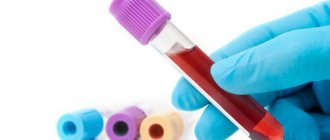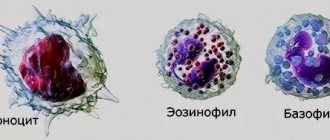Nature gave blood a special property - to coagulate; without this, even minor tissue damage would be fatal - a person would simply die from blood loss. But in some pathologies this process is disrupted. By taking a blood clotting test and learning how the hemostasis system works, you can judge the presence of many diseases in the body.
APPOINTMENT WITH ANY DOCTOR BASED ON TEST RESULTS—RUB 500. CLICK TO SIGN UP
Determination of blood clotting ability is called a coagulogram (hemostasiogram). The study is prescribed to identify a number of pathologies (hemophilia, cancer, thrombosis, liver disease, kidney disease, etc.) and before surgery or childbirth.
Normally, hemocoagulation should take place only outside the body, otherwise the resulting clots will travel through the vessels to the heart, lungs or brain, forming blood clots and causing ischemia, heart attacks and strokes. By donating blood for clotting, you can determine its ability to coagulate (clotting). This helps the doctor assess the risk of bleeding or developing clots in the blood vessels.
Types of laboratory tests for clotting
The content of the article
The blood clotting test includes the following indicators:
- Fibrinogen levels
This substance is a protein produced by the liver. In a healthy person, fibrogen is 2-4 g/l. - Antithrombin III.
This is a hemocoagulation regulator. The antithrombin index is 75-125% in adults, 80-120% in children older than one month, and 30-80% in newborns. - Prothrombin index (PTI)
. The percentage ratio of hemocoagulation time in a particular person with a similar indicator in the control sample. Normally, PTI is 93-107%. - Thrombin time.
In healthy people it ranges from 14 to 20 seconds. During this period, prothrombin must be transformed into thrombin. The results may vary with the use of certain medications, such as aspirin or warfarin. The thrombin time (PT) test shows how well a person's blood clots. - Activated partial thromboplastin time (aPTT)
. The indicator is used to monitor the hemocoagulation process in patients prescribed heparin and in the diagnosis of DIC syndrome. Normally, this figure is 29-39 seconds. - Period (time) of bleeding.
Indicates how quickly the blood will stop if the integrity of small vessels is violated. To do this, a puncture is made on the patient's finger and the time is noted. Normally it is 2-3 minutes. - Clotting time.
Determined by the time interval between blood sampling and clot formation. In healthy people, this process takes from 2 to 5 minutes. - D-dimer
. This is a substance formed as a result of the decomposition of fibrin. Normally, this figure should be no more than 250 mcg/l (0.25 mcg/ml).
How to donate blood for clotting
Determination of bleeding time is carried out using capillary blood; for other clotting tests, material must be taken from a vein.
The tests are carried out on an empty stomach; you can only drink water before the analysis. If you are taking any medications, you should tell your doctor about this, as some medications may affect the results obtained.
By regularly taking hemostasiogram tests, you can promptly diagnose many dangerous ailments.
Increased blood clotting and thrombus formation
Many factors can lead to increased blood clotting, restriction or blockage of blood flow, and as a result, blood clots. Blood clots can travel through arteries and veins, causing serious consequences including sudden death from embolism.
Indications for examination
Normal blood clotting is 2-5 minutes (according to Sukharev). An analysis to determine this indicator (coagulogram, hemostasiogram) is prescribed for:
- diseases of internal organs;
- suspected hereditary hemostatic pathologies;
- pregnancy;
- varicose veins, thrombus formation;
- diabetes mellitus;
- prescribing coagulants;
- during the preoperative and postoperative period.
Risk factors
Increased hemocoagulation often occurs when:
- increased number of blood cells and hemoglobin, radiation, cancer;
- hyperfunction of the spleen, acidification and dehydration of the body, most often associated with poor bowel function;
- increased consumption of sugar and carbohydrates;
- overweight, pregnancy, prolonged bed rest, sedentary lifestyle and sedentary work;
- lack of specific hormones and enzymes, use of birth control pills or hormone replacement therapy.
Sometimes the tendency to hyperclotting is congenital. This pathology is called thrombophilia. It is caused by a congenital decrease in the level of anticoagulants C and S, antithrombin III, coagulation factor VII, heparin cofactor II, dysfibrinogenemia, sickle cell anemia, hyperlipoproteinemia, increased activity of Hageman factors, Rosenthal factors and antihemophilic globulin. With this pathology, patients report similar cases among close relatives. Sometimes hereditary thrombophilias cause miscarriages in women.
Blood thickening in old age threatens to disrupt brain activity, and in pregnant women it can negatively affect the condition of the mother and fetus. Poor rheology leads to ischemia of organs and tissues, which negatively affects the condition of the entire organism.
How to suspect increased coagulability
- A sign indicating increased hemocoagulation is thrombus formation. If you notice painful bluish “vessels” or nodules on the limbs, this is a reason to consult a doctor and be examined for blood clotting indicators.
- Another symptom that should alert you is problems with the functioning of the heart. They should encourage you to get tested.
If the coagulogram indicators do not correspond to the norm, treatment must be started urgently to prevent thromboembolism.
Time tests
Clotting time is included in the parameters of hemostasis. There are circumstances when it is necessary to know about this indicator, for example, during a certain period of life or during a person’s illness. Most often, studies are carried out by taking part of the blood.
The clotting period is divided into two stages:
- Primary hemostasis . At this time, to stop blood loss, vasoconstriction occurs and a blood clot is mechanically formed to prevent bleeding from the site of platelet damage.
- Secondary hemostasis is coagulation.
General recommendations for all analyzes include:
- Almost all tests are taken in the first half of the day, since over the next hours the indicators may change depending on nutrition, physical activity, etc.
- During the day before the test, food should be light, and 12 hours before going to the laboratory, eating is completely prohibited.
- You should not drink sugary drinks at this time. It is better to drink regular boiled water.
- You should definitely notify your doctor about taking medications.
It is very important to know over what period these two stages should normally occur. For this purpose, special analyzes are carried out.
The video explains how to determine blood clotting using a general analysis and at home:
According to Sukharev
For this test you do not need to donate blood from a vein. The sample is taken from a finger, since capillary biological fluid is sufficient. This test examines the amount of enzymes.
Attention! Thanks to blood testing according to Sukharev, doctors can learn about the body’s ability to withstand severe blood loss or other hemostasis disorders.
At the same time, the analysis gives a general picture of the state of the nervous and endocrine systems.
How the analysis is carried out:
- In the morning before the test, you cannot eat anything; the test itself involves taking blood in the morning.
- It is acceptable to drink ordinary water, but without gas.
- First, a puncture is made in the finger using a scarifier needle, and the required amount of plasma is squeezed out of it.
- To check the thickness of the blood, the laboratory technician begins to rock the test tube so that the liquid flows down the walls; depending on the time of flow, the result is recorded. That is, the time is recorded from the beginning of blood flow to the formation of a clot.
What results does Sukharev’s method give:
- If the clotting time is normal, then this indicates the absence of diseases associated with hemostasis.
- If clotting occurs in a short period of time, there is a risk of blood clots. An exception may be pregnancy, when rapid blood clotting is due to the protective functions of the body. A similar phenomenon can occur after taking contraceptive medications. This is also observed after childbirth, operations, heavy blood loss, extensive burns, and certain illnesses.
- If clotting does not occur for a long time, then the person loses a lot of blood, which affects his well-being and can be life-threatening. This happens due to various pathologies or while taking certain medications.
A normal analysis indicator is considered to be a clotting time in a healthy person of 3 to 5 minutes.
In childhood, this figure is slightly reduced and is 2-5 minutes.
In older people, for health reasons and some physiological changes in the body, the clotting time is reduced to 1.5-2 minutes , as the liquid becomes thicker.
The same indicators during pregnancy ( 1.5-2 minutes ). This is due to the fact that the body develops protective mechanisms to protect the growing fetus.
Diseases accompanied by increased blood clotting
- Atherosclerosis. With atherosclerosis, plaque forms inside the arteries. Over time, the plaque can rupture and platelets form clots at the site of injury.
- Vasculitis causes inflammation of blood vessels, platelet aggregation and, as a result, an increase in coagulogram parameters.
- Diabetes causes plaque to form in the arteries, which is why nearly 80 percent of people with the disease eventually die from causes related to blood clots and ischemia.
- In heart failure, this organ cannot pump enough blood to meet the body's needs, its circulation slows down, it thickens and blood clots appear.
- High blood clotting is often observed in patients with varicose veins. In this case, blood clots have to be “liquefied” with the help of special drugs to prevent gangrene and necrosis associated with poor blood flow.
- This figure also increases in some infectious diseases, especially those accompanied by fever. In this case, the blood becomes viscous, so patients are prescribed plenty of fluids and intravenous infusions of solutions.
Elevated coagulogram values are very dangerous, as this condition can lead to serious complications and serious consequences.
Basics of Keeping Blood Fluid
Blood maintains the constancy of its structure. This means that, on the one hand, it must be thick enough so as not to sweat through the vascular wall under the influence of pressure in the vessels, which is pumped up by the heart. On the other hand, blood that is too thick will not be able to circulate through the capillary networks and other vascular structures of the microvasculature. Therefore, it must have a balance that is controlled by the system of coagulation (coagulation) and anticoagulation (anticoagulation). Collectively this is called coagulation homeostasis. As long as both systems are in harmonious interaction, the body functions normally.
Important to remember! Impaired blood clotting can cause many diseases, primarily those associated with blood vessels and the heart. But this is not its only meaning. It almost always changes its coagulation properties against the background of severe pathology!
Blood coagulation and the ability to form a clot are affected by:
- Condition of the vascular walls. Violation of the structure of the inner layer of arteries triggers processes of increased coagulation;
- The number and functional usefulness of platelets. They are the main overseers of the integrity of the vascular bed and are the first to initiate the process of accelerated coagulation;
- Concentration and state of plasma coagulation factors. Most of them are synthesized by the liver with the participation of vitamin K and the vascular endothelium. An increase or decrease in their number leads to an increase or decrease in blood clotting;
- Concentrations of plasma factors of the anticoagulation system (antithrombin, heparin, antiplasmin and others). The more there are, the thinner the blood.
How to suspect deterioration of coagulation hemostasis
The first signs indicating poor blood clotting
Prolonged bleeding occurs with minor skin injuries or after injections. Normally, cuts or injections should not bleed for more than 3-5 minutes, but if there is pathology, this time can increase significantly. Sometimes such people have hemorrhages under the skin.
Another symptom that indicates this condition is prolonged nosebleeds that are difficult to stop. Women with hemocoagulation disorders may experience menorrhagia and metrorrhagia. Sometimes traces of blood may even be present in urine and feces.
If these symptoms appear, it is recommended to donate blood for a coagulogram. Research conducted by our specialists will help identify disorders of coagulation hemostasis. All analyzes are carried out using modern equipment and reagents.
Reasons causing deterioration of hemocoagulation
Medications
- Coumarin group drugs reduce coagulation because they are vitamin K antagonists. These drugs are used to protect against thrombosis after major operations, but if prescribed incorrectly, these substances can significantly worsen blood clotting.
- Aspirin, often used for colds and heart pathologies, taken in high doses, can also cause a decrease in clotting rates.
- In some cases, this effect is achieved by a combination of several drugs that are not recommended to be taken together.
In such cases, after determining the clotting time and duration of bleeding, the patient is prescribed vitamin K, which plays an important role in the process of hemostasis. Patients are recommended to eat green vegetables (cabbage and spinach), eggs, milk and cereals, which eliminate the deficiency of this vitamin.
Hereditary diseases
- Hemophilia . This disease is hereditary and affects only boys. In patients, symptoms of decreased blood clotting appear in early childhood. With this disease, various coagulation factors may be absent, so the disease may be more or less severe. Patients are treated by a hematologist for life. Replacement therapy, blood transfusions and restriction of physical activity are carried out.
- Von Willebrand syndrome is also characterized by decreased clotting, but it affects both men and women. To treat patients, tranexamic acid, desmopressin are used, and blood transfusions are performed.
Other pathologies
A decrease in the number of platelets (thrombocytopenia) occurs in various anemic conditions, leukemia, after radiation therapy, viral infections, taking antibiotics and some other drugs. This condition can be caused by diseases of the liver, kidneys and spleen. This condition is treated by administering special blood products.
Another reason for impaired hemocoagulation is liver disease, which disrupts the synthesis of substances responsible for proper hemostasis. A decrease in PTI and an increase in blood clotting time are considered as an indirect sign of hepatitis.
A decrease in coagulogram parameters may be observed after operations accompanied by heavy blood loss. This condition does not pose a threat to human health and goes away on its own.
Properly selected treatment to reduce hemocoagulation will help avoid severe blood loss and serious complications.
General rules for conducting analyzes
Regardless of what coagulogram indicator will be examined and what kind of blood is needed for it, the subject must adhere to certain rules:
- Blood sampling is carried out in the morning;
- Avoid eating 8-10 hours before the test and drinking alcohol the day before;
- Avoid smoking 3-4 hours before the test;
- Immediately before taking the test, it is advisable for the body to remain at rest for several minutes.
Blood collection and analysis depends on its type. Those methods that require capillary blood are carried out immediately after puncturing the skin of one of the fingers with a scarifier or a special needle. If venous blood is needed for research, about 20 ml of it is taken according to the general rules in one of the peripheral veins. After collection, it must be delivered to the laboratory within 2 hours and centrifuged to obtain plasma. It is this part of the blood that is examined during the determination of coagulogram parameters.
Blood clotting indicators during pregnancy
Every pregnant woman registered at the antenatal clinic is necessarily referred by a gynecologist for an analysis called a hemostasiogram. The results of a hemostasiogram make it possible to determine the presence of disorders in the blood coagulation system, if any.
The role of hemostasis during pregnancy
Hemostasis acts as a “thickener” of blood; thanks to this system, a person avoids significant blood loss in cases of vascular damage. In tandem with the coagulation system, an anticoagulant acts in the body - a “thinner” of the blood. When the balance is disturbed, the systems malfunction, as a result, the blood can become too viscous, which leads to the formation of blood clots, or too liquid, in both cases the blood clotting time changes.
What are the dangers of impaired hemostasis for pregnant women?
Increased blood clotting during pregnancy can provoke disseminated intravascular coagulation syndrome, in which thickening blood in the vessels causes disruption of placental blood flow. The condition is dangerous for the baby, as he cannot receive adequate nutrition, which immediately affects his development. In severe cases, pregnancy may stall, and ultimately the fetus dies. Timely testing for hemostasis gives a great chance to avoid such complications.
Disorders of the coagulation system can cause premature separation of the placenta, even if it is in a normal location.
When is it necessary to take a blood clotting test?
It is recommended to perform a hemostasiogram before the expected pregnancy. In case of poor performance, you can undergo a course of therapy, which the doctor will select individually. The risk group that requires mandatory preliminary screening for coagulation includes women:
- having relatives who have suffered a stroke, heart attack, thrombosis, varicose veins;
- suffered a miscarriage or frozen pregnancy;
- athletes and those working in heavy work.
During pregnancy, it is also necessary to undergo diagnostics, especially if the doctor diagnoses:
- recurrent miscarriage - the presence of two or more unsuccessful pregnancies (miscarriage, fading);
- gestosis - swelling of the extremities, protein in the urine, high blood pressure;
- threat of miscarriage.
If there is gestosis during pregnancy, blood clotting increases in 70% of cases, which aggravates treatment. You can also prevent the situation by taking a timely test and undergoing therapy.
Methods for treating hemostasis disorders in pregnant women
With timely diagnosis of hemostasis disorders, many complications of pregnancy can be avoided. In European medical practice, DIC syndrome is treated with low molecular weight heparins, which are absolutely safe for the fetus. Treatment can be done at home with the permission of a gynecologist, subject to control tests (every 2 weeks). At the same time, doctors prescribe antioxidants, aspirin-containing drugs, folic acid, and vitamin B.
If the patient does not have the opportunity to buy expensive low molecular weight heparins, the specialist can replace them with regular heparin. In this case, strict monitoring of the results and condition of the pregnant woman is necessary, since the dose of an unfractionated drug is very difficult to select immediately; you will have to visit the clinic twice a week. For control, you need to periodically take a blood clotting test.
What is this and what does it affect?
It is very important to know how thin or thick a person’s blood is.
Attention! Clotting is an important indicator of health. This is primarily a protective function of the body. This way there is no blood loss and its volume is maintained.
The mechanism of coagulation depends on the physicochemical actions in the molecular system of the plasma:
- The main place in this is occupied by a protein called fibrinogen.
- During the reactions that take place, it is converted into fibrin (which is not able to dissolve), which falls out in the form of the thinnest threads.
- These threads can form into a dense network with small cells that trap the formed elements.
- These changes lead to the formation of a blood clot. As it exists, its base becomes compacted, the edges of the wound are tightened and healing occurs.
- As the clot tightens, it forms a yellowish liquid called serum.
Platelets, which are part of the plasma, influence the compaction of the blood clot.
To use a primitive comparison, the process of blood clotting is reminiscent of the process of turning milk into cottage cheese, when casein (milk protein) coagulates and whey is released. Over time, the wound resolves and the fibrin clot dissolves.
The plasma coagulation test is used when the presence of the following diseases is suspected:
- pathology of the liver organ,
- disorders of the immune system,
- varicose veins.
Specialists also send patients for hemostasis testing before surgery, during pregnancy, and in case of possible large blood losses.
The video explains how the blood clotting system works:










